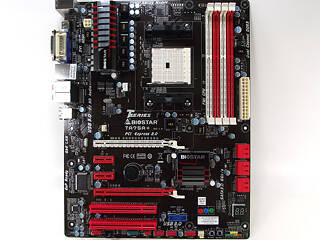 0
0
Biostar TA75A+ Socket FM1 Review
The Board - A Closer Look »The Board - Layout
With the board out of the box, the stylized theme of the Biostar TA75A+ really impresses, with the red, black, and white color theme broken here and there with a bit of hardcore metal. The rear of the board is simple and clean, thanks to the impressive connectivity of the AMD A75 chipset, allowing for simplistic board design.
The socket area of the board is quite clean and simple like the rest of the board, with the CPU_FAN1 power header in a non-standard location, at least for us, found below the CPU VRM. The rear of the socket, in contrast to many other boards we've looked at, is almost completely clear of protruding pins that might interfere with aftermarket backplates, with many solder "cooling strips" beneath the CPU VRM to help dissipate heat. The backside of the socket proper is completely filled with components, with not a single empty spot noticed.
With six expansion slots, the Biostar TA75A+ comes with two of everything, PCIe x16, PCIe x1, and PCI all inclusive. The white PCIe x16 slot is connected to the APU with a x16 link, while the red x16 slot is connected to the APU via a x4 link, the perfect pair for an add-on RAID card and a discrete GPU. The four DIMM slots can each be fitted with high density 8 GB DIMMs, while claiming support for up to a 2000 MHz speed.

We find all of the pin headers for internal expansion along the bottom edge of the board, with the addition of power and reset switches right next to the front panel pin header, making first set-ups a breeze. All of the pin headers, minus the front panel and COM header, are fitted with red plastic bases, really adding to the colored theme of the board, something that we really did not expect from such an inexpensive product. The TA75A+ features three separate fan headers, but only the 4-pin PWM CPU_FAN header can be controlled from within the BIOS and via included software.
On the board's right edge we find six SATA ports, each supporting 6 Gb/s drives. The backplate I/O starts off with a PS/2 port for keyboards and four USB 2.0 ports, quickly followed by a set of HDMI, VGA, and DVI ports driven by the APU's onboard Radeon cores. We also find a set of dual USB 3.0 ports, a six port audio header, and rounding it all out is a single RJ-45 LAN connector.
The board's chipset has a relatively small cooler on it, with a low profile so as to not interfere with expansion cards. Removing the stylized heatsink we find the AMD A75 chipset below, set at a 45-degree angle like AMD's current line of high-performance GPUs.
Apr 25th, 2024 18:24 EDT
change timezone
Latest GPU Drivers
New Forum Posts
- How to check flatness of CPUs and coolers - INK and OPTICAL INTERFERENCE methods (112)
- Best SSD for system drive (78)
- Which new games will you be buying? (314)
- TPU's Nostalgic Hardware Club (18464)
- Post your Cinebench 2024 score (450)
- Ubuntu 24.04 LTS released (2)
- Dell Workstation Owners Club (3054)
- im new to throttelstop and i think i messed it up by copying others any hints would be very much aprreciated (2)
- Ryzen Owners Zen Garden (7243)
- What software are you using to monitor CPU temps during gaming session? (15)
Popular Reviews
- Fractal Design Terra Review
- Thermalright Phantom Spirit 120 EVO Review
- Corsair 2000D Airflow Review
- Minisforum EliteMini UM780 XTX (AMD Ryzen 7 7840HS) Review
- ASUS GeForce RTX 4090 STRIX OC Review
- NVIDIA GeForce RTX 4090 Founders Edition Review - Impressive Performance
- ASUS GeForce RTX 4090 Matrix Platinum Review - The RTX 4090 Ti
- MSI GeForce RTX 4090 Suprim X Review
- MSI GeForce RTX 4090 Gaming X Trio Review
- Gigabyte GeForce RTX 4090 Gaming OC Review
Controversial News Posts
- Sony PlayStation 5 Pro Specifications Confirmed, Console Arrives Before Holidays (117)
- Windows 11 Now Officially Adware as Microsoft Embeds Ads in the Start Menu (106)
- NVIDIA Points Intel Raptor Lake CPU Users to Get Help from Intel Amid System Instability Issues (106)
- AMD "Strix Halo" Zen 5 Mobile Processor Pictured: Chiplet-based, Uses 256-bit LPDDR5X (101)
- US Government Wants Nuclear Plants to Offload AI Data Center Expansion (98)
- AMD's RDNA 4 GPUs Could Stick with 18 Gbps GDDR6 Memory (87)
- Developers of Outpost Infinity Siege Recommend Underclocking i9-13900K and i9-14900K for Stability on Machines with RTX 4090 (85)
- Windows 10 Security Updates to Cost $61 After 2025, $427 by 2028 (84)











